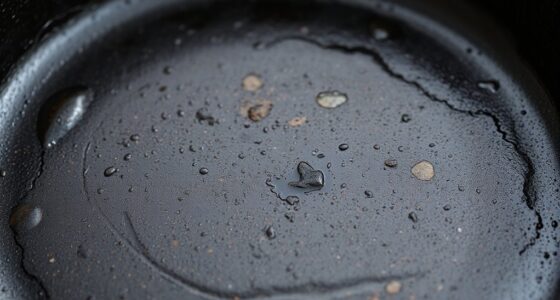If you've added too much lemon juice to your soup, there are several ways to fix it. Start by adding sugar or honey to counteract the sharpness; just a teaspoon can make a difference. You can also dilute the soup with extra stock or water. Incorporating neutral ingredients like potatoes or white beans can help absorb the acidity. For a creamy texture, mix in some cream or sour cream. Keep exploring other tricks to perfect your dish!
Key Takeaways
- Add sugar or honey to balance the sourness without turning the soup into a dessert.
- Dilute the soup with more stock or water, adjusting seasonings afterward for flavor depth.
- Incorporate neutral ingredients like potatoes or white beans to absorb acidity and enhance heartiness.
- Use a pinch of baking soda to neutralize acidity quickly, but monitor the taste closely.
- Stir in creamy ingredients like cream or sour cream to soften the lemon flavor and add richness.

Too much lemon juice in soup can turn a comforting dish into a sour disappointment. If you've found yourself in this predicament, don't fret; there are several effective ways to salvage your soup. The key lies in balancing the sourness of the lemon with other flavors, making it enjoyable again.
One of the easiest methods to counteract that sharp lemon flavor is by adding sugar. Start with a small amount—just a teaspoon or so—and stir it in. Taste as you go, adjusting until the sourness is balanced to your liking. Sugar doesn't just mask the lemon; it enhances the overall flavor profile of the soup, making it more pleasant. If you prefer a more natural sweetener, honey works just as well. Just remember, you're aiming to balance the sourness, not create a dessert!
If the lemon flavor is still too prominent, consider diluting the soup. Adding more stock or water can help reduce the lemon flavor while maintaining the soup's integrity. However, keep in mind that this might require you to adjust seasonings afterward, as the dilution may also lessen other flavors. You might need to sprinkle in some salt, pepper, or herbs to regain the depth of flavor you desire.
Incorporating neutral ingredients can also be a game-changer. Think about adding potatoes or white beans. These ingredients absorb some of the acidity from the lemon, mellowing the overall flavor of the soup without overpowering it. Plus, they add substance, making your soup heartier and more satisfying. You'll be surprised at how effective these neutral ingredients can be in toning down that sharp tanginess.
If you’re looking for a quick fix, adding a small amount of baking soda can neutralize the acidity of the lemon juice. However, proceed with caution; too much can alter the flavor and texture of your soup. A pinch usually suffices. This method is particularly useful if you’re in a hurry and don’t have other ingredients on hand. Remember that balancing flavors is essential in cooking, especially when working with acidic ingredients. If you’re unsure about how to balance lemon juice flavor, start by adding a tiny amount of baking soda and taste as you go, adjusting gradually to avoid overdoing it. Alternatively, you could complement the acidity with a touch of sweetness, such as sugar or honey, which can also help achieve a more harmonious flavor profile in your dish.
For those who love a creamy texture, consider adding dairy products like cream or sour cream. Not only do these ingredients help soften the lemon taste, but they also lend a luxurious feel to your soup. The creaminess balances the acidity beautifully, making for a rich and comforting dish.
Ultimately, adjusting your soup after adding too much lemon juice is all about personal taste. Experiment with these methods until you find the perfect balance for your palate. Whether you opt for sugar, dilution, neutral ingredients, or creaminess, you'll be well on your way to transforming a sour disappointment back into the comforting bowl of soup you envisioned. Enjoy the process and happy cooking!
Frequently Asked Questions
How to Tone Down Lemon Flavor in Soup?
To tone down the lemon flavor in your soup, start by gradually adding more broth or water, tasting as you go to check the balance.
You can also toss in neutral ingredients like potatoes or white beans to absorb some acidity.
A pinch of sugar or honey can counteract the sourness, while creamy elements like sour cream can mellow the flavor.
Don't forget to experiment with herbs to enhance the overall taste!
What to Do if You Put Too Much Lemon Juice in a Recipe?
Did you know that over 80% of home cooks admit to accidentally adding too much acid to their dishes?
If you find yourself in this situation, don't panic! Start by balancing the flavors with sugar or honey. You can also dilute the dish with extra liquid, like broth.
Adding neutral ingredients, such as potatoes, can absorb some acidity. If it's still too sour, consider starting fresh with a new batch to avoid disappointment.
What Can Neutralise Lemon Juice?
To neutralize lemon juice, you can add baking soda, but be careful; it might change the dish's flavor.
Incorporating neutral vegetables like potatoes or white beans can help absorb the acidity.
You could also counteract the sourness with a pinch of sugar or honey.
Diluting the juice with extra stock or water works too.
Lastly, creamy ingredients like sour cream can mellow out the acidity, balancing the overall taste beautifully.
How to Reduce the Effect of Lemon in Food?
When you want to reduce the effect of lemon in your food, start by balancing its sourness. You can add a pinch of sugar or honey; they'll counteract the acidity beautifully.
Incorporating neutral ingredients, like potatoes or cream, can also help mellow the flavor.
If you're feeling adventurous, try adding umami-rich foods like mushrooms or bacon, which enhance the overall taste while distracting from the sharpness of lemon.
Enjoy your balanced dish!
Conclusion
So, if you've overdone the lemon juice in your soup, don't fret—just follow these simple steps. Balancing acidity is easier than you think, and while some might argue that diluting the soup could compromise its flavor, you can actually enhance it by adding complementary ingredients like cream or potatoes. Remember, cooking is all about creativity and adjustments, so embrace the process and savor the improved taste. Your soup will be deliciously enjoyable in no time!
Cindy thoroughly researches juicing trends, techniques, and recipes to provide readers with practical advice and inspiration. Her writing style is accessible, engaging, and designed to make complex concepts easy to understand. Cindy’s dedication to promoting the advantages of juicing shines through her work, empowering readers to make positive changes in their lives through the simple act of juicing.











